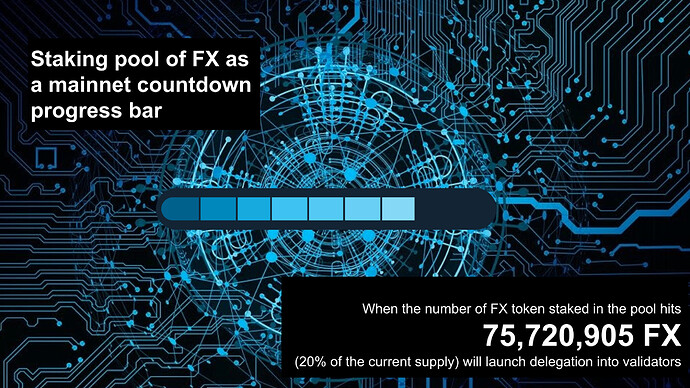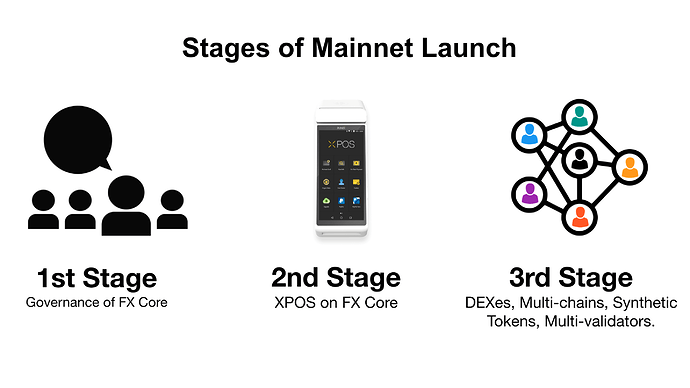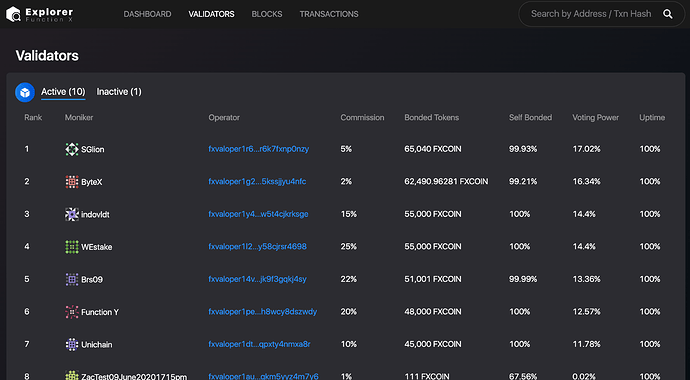Let the countdown begin.
Launch introduction
Function X Mainnet will be going live.
Foremost, thank you, Community, for your gracious patience and your unwavering support. We should all feel a sense of achievement because Function X Mainnet is going live.
The team will do a step-up Mainnet launch, whereby you will see a multi-stage launch. A multi-stage launch ensures better security, adoption, and exposure. In Stage 1 of this multi-stage launch we introduce the delegation of FX tokens into validators to help secure the Function X Mainnet. We call this first stage “Governance of FXCore”.
Remember because Function X blockchain is capable of launching many blockchains (eg., a team can launch a blockchain in 30 minutes using our Function X Cloud) we call the first Function X blockchain “FXCore”. FXCore connects all Function X blockchains together. Read here to learn how to create blockchain on Function X Testnet.
When the FX tokens in the staking pool reach 75,720,905 tokens, the Mainnet will then go live within seven days. In other words, we need 20% (75,720,905/378,604,525) of the tokens generated in the ecosystem to stake for rewards. If holders of 20% of FX tokens are willing to stake their FX to earn what we believe is an attractive reward, we believe that signifies sufficient support to secure the network when the right incentive is provided. With that number, mainnet goes live.
Mainnet: Launch Logic
Function X’s underlying consensus model is PoS (Proof of Stake).
Simply, every block’s information has to be individually verified by two-thirds of the validators. Validators verify the authenticity by voting to approve the block. If 66.7% (⅔) of all validators approves a block, the block will officially be part of the blockchain. Likewise, if less than 66.7% of validators accept a particular block, suspecting it of wrong information, that block will be rejected. The cycle repeats itself and the blockchain grows.
At the centre of this decentralization is a system of rewards and penalties.
For validators that diligently participate and grow the ecosystem, they are rewarded with more FX tokens.
For those that are malicious, the FX tokens that they originally staked to qualify for the validator position will be forfeited.
In theory, the FX holders are the least likely to attack the system because by attacking the system they will be abandoning the ecosystem and their FX tokens would become valueless. Therefore, stakeholders (FX holders) are fully incentivized to protect the blockchain, as the stronger and more trusted the blockchain is, the greater the value of the FX tokens. It is an incentive loop that rewards FX holders to be validators and behave accordingly.
There is, however, a loophole.
When the network is in its infancy, there is a limited number of FX tokens participating in the governance process. During this period, the network can be vulnerable to attack.
Take for example, if there is only 100M FX in circulation, but only 1M FX is participating in the validation process (contributed by validators personally and through others delegating FX to the validators). In this situation, only 1% of FX tokens are in the governance process, and based on the 66.7% block approval rate, a malicious person only needs 2.1M FX (2.1% of the total tokens) to take over the network to destroy the value of all tokens.
Rome was not built in a day. A blockchain needs time to grow. We are lucky to be standing on the shoulders of giants, learning from the recent successes of the ETH2.0 pre-launch staking. Therefore, in Function X’s case, to avoid this loophole, once 75,720,905 FX tokens are staked we will launch the “Governance of FXCore”. While we might think it is an easy number to achieve in hours, that is not always the case even if our project is one of the most active in the crypto space.
For example, the initial staking requirement of ETH 2.0 was 542,247 ETH, and it resulted in 900,129 ETH (66% above the initial target) but it actually took awhile. We are hopeful that we can replicate the success of ETH 2.0 staking and bring the Function X network to the next level. The journey of this accumulation process is also the process of raising awareness of the Function X network.
First Stage: Governance of FXCore
As we’ve indicated, we will open up f(x)Wallet entry-stage staking on 6th April and once we reach 75,720,905 (20% of 378,604,525) the FX mainnet will go live and governance stage delegation will be opened, which is also called governance delegation. Once mainnet is live, FX holders will have the option of continuing to stake from their entry-stage reward (as it runs for ten weeks from 6th April), or move FX tokens into FXCore for governance stage delegation. This is the first stage of the mainnet launch — Governance of FXCore.
Governance of FXCore starts when users delegate FX tokens to validators to participate in governance. Users will have the responsibility of securing the network — and likewise will be undertaking the risks and enjoying the rewards of this endeavor.
It is likely that while entry-stage staking rewards are still going on, users will have the choice to continue earning FX through entry stage staking or through delegation of tokens to validators. Both paths can produce user rewards, but the latter — delegating to validators — is real life action which entails real-life risks and rewards. The reward gained through delegation into validators will likely be higher than through entry-level staking, but at the same time it will also be riskier: if the validator doesn’t behave well there will be a penalty.
Examples of non well behaved actions aka malicious actors include proposing a block with wrong information, instead of David (example address: Fx020202….) sending 1 FX to Zac (example address: FX030303…) the block says Zac sent 1 FX to David, so now David owes Zac tokens which is untrue.
To mitigate the consequences of possibly accidental missteps that would result in a penalty, the Function X foundation and Pundi X will jointly manage the first 20 validators enabling you to delegate to one of those validators together with us.
While there is no guarantee that there will be no penalty, the likelihood is much lower, and if there is our own company and governance tokens would also be penalized.
In short the first 20 validators are run by us, and the next 30 will first be open to those that have tested as validators during our Testnet 1.0, Testnet 2.0 and Testnet 3.0. Our ultimate objective is that once the mainent is mature enough, anyone (anonymous and those self-compiling our open source code) can join the mainnet as a validator.
Once XPOS on FXCore goes live, the second stage will go live.
Second stage: XPOS on FXCore
Running XPOS on the FXCore is a great way of introducing the Function X mainnet. It is a ready-made, real-time use case for the mainnet.
We will first use Function X in a high performance, real-time payment scenario for XPOS. For example, when a user in Nigeria pays for his morning coffee using f(x)Wallet on a local XPOS, this transaction will be shown on the Function X blockchain explorer. Obviously, it will not show the user’s identity, but it will show his FX public address (eg:fx010101…), the payment (in $PUNDIX) and the transaction fee ($FX as gas fees).
This second stage will demonstrate our ability for f(x)Wallet to directly interact with XPOS on-chain. Other on-chain non-custodial blockchain wallets such as Trust Wallet, ImToken and others will follow, whereby if you use a non-custodial wallet to pay on XPOS, your transaction will also be recorded on the Function X blockchain.
Third Stage: DEXes, Multichains, Synthetic Tokens, Multi-validators.
DEX:
For those of you who have been following our #HashOut articles, you know that FXCore will support decentralized exchanges. Every strong blockchain needs strong exchanges and we will have the first one built in-house.
We believe that in the future, other teams will run crypto exchanges better than us, while we focus on the underlying FXCore to service the exchanges.
Multichain:
Function X has a multichain architecture and is designed to work with different blockchains. In other words FXCore not only connects various Function X blockchains, but is also capable of connecting to Ethereum, Bitcoin BSC, Polkadot and more.
Read here to learn how to do cross-chain transaction on Function X Testnet 3.0.
Synthetic tokens:
A key strength of our DEX is that we have built it with synthetic assets and tokens in mind. Users will be able to use our tokens (and other tokens) to collateralize and synthesize new tokens to be traded on our DEX. The tokens can be synthetic stocks, synthetic ETFs, synthetic fiats and more. The FX tokens that you hold will be the voting power to choose and manage these synthetic tokens.
Synthetic tokens’ success will depend on a decentralized price oracle. We look forward to working with the best in the industry so that token prices can be reliable and truly reflect the liquidity and pricing Oracles. Another really important part of the DeFi ecosystem are oracle services that focus on delivering reliable data feeds from the outside world into smart contracts.
Multi-validators
For those who have followed our development, you know that one of our central objectives is to achieve full decentralization. After the initial phase where we will be providing 20 validators, we will move to allow those that have participated in Testnet 1.0, 2.0 and 3.0 in 2020 to be validators. At the same time, we will further open it up to crypto exchanges, other crypto teams, universities and trusted third parties. As we said, finally anyone (including anonymous parties with FX tokens) can participate.
Validators in Testnet 1.0
So Mainnet countdown begins
We think of Function X as a journey to create a fully decentralized blockchain ecosystem. What we’ve set out here with the launch of the Function X Mainnet is a significant milestone on that journey. Our core value of “accessibility” has been the guiding light in how we’ve built this version of the Function X Mainnet.
For many cryptocurrency enthusiasts, Decentralized Finance (DeFi) has remained somewhat (or completely) elusive. What we’re hoping to do with this roll-out of the Mainnet is a first step to bring DeFi to the masses — to those who have been ignored by the traditional financial system (the “unbanked” and “underbanked”) as well as those who are looking for a more efficient, equitable and open way to participate in traditional financial services such as payments, lending, borrowing, investing and trading.
DeFi is certainly a hot topic, but it needs to be approached with caution. The axiom of “Do Your Own Research” is perhaps more relevant in the DeFi space than anywhere else in the crypto world. While the great returns that others report are alluring, it’s important to keep in mind that greater returns come with increased risks, so apply a critical eye to everything in the DeFi space and be responsible with how you manage your funds.
In addition to our own commitment to realize the goal of Function X, we are motivated and energized by the enthusiasm and support of our growing Community. Sustaining that Community enthusiasm and support is critical to our success.
Thank you for joining us on this journey.
-Danny Lim, David Ben Kay, Peko Wan and Zac Cheah on behalf of the Function X Team




